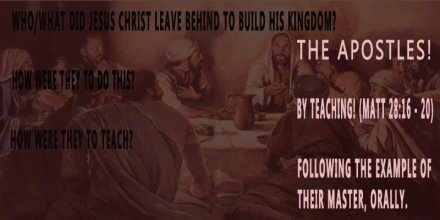The second part of the series “Pillars of Catholic Authority”. The first part “In the beginning, there was… ” can be found here.
THEN THERE WAS…
The Apostles taught mainly in the same manner as their master; orally, that is. “He who hears you hears me; and he who rejects you, rejects me; and he who rejects me, rejects Him who sent me.” (Lk 10:16).
But due to the vast area and the number of cities they had to travel to, St Paul mainly started writing letters to communicate with the different Church commuities of that time. This letters were mainly responsed to questions or complaints that were sent to him.
After his death, some of his disciples and admirers followed in his footsteps writing letters containing advice and teachings which they believed were “faithful” to Paul’s mind. Examples of these letters are 2 Thessalonicans, Colossians and Ephesians.
During this time also, a number of narratives of the Life of Jesus were penned down to preserve an eyewitness account for their immediate readers (1st Century Christians) and for those who may come after them.
Problem of Limited Readership
Due to the stress involved in writing a book (not to mention replicating one), almost all the books written could only be read by those in a particular city or area or to whom they were addressed. In other words, those in Corinth were able to read only 1 and 2 Corinthians which were written and sent to them, they could not read the book of Romans which was written and sent to Rome.
Fake “Apostolic” Writings
Then, some individuals outside the Church started writing their own versions of the Gospel adding into it, different stories from what happened and naming it after Apostles to make them seem to be True Apostolic Books. Examples are “The gospel of Thomas”, “The gospel of Mary”, e.t.c. Some also wrote their own epistles and sent them out claiming that they were truly apostolic.
The Old Testament
The Apostles and Early Christians taught and evangelised in the Greek language and so they quoted from the Greek translation of the Sciptures known as the “Septuagint”. This version was composed by Alexandrian Jews and in it were not just books written/preserved in Hebrew-Aramaic but also those in Greek. The Septuagint contained 46 books and this Canon of the Old Testament was adopted by the Early Church.
Creation of Individual Canons
Due to this, the Apostles and leaders of the Church started individually to decide which books(among the ones they had received) were apostolic and which were not. They also instructed christians telling them which books they were to accept and teaching them how to know if a book was apostolic or not. An example is found in Galatians 1: 8 – 9.
Over time, Bishops continued to create canons of New Testament (A canon is a list, in this case, a list of approved books to be taken as Scripture) for the areas/christians under them. In 367 AD, Saint Athanasius, Bishop of Alexandria, Egypt made a canon of the New Testament that contained only 27 books saying “In these alone is proclaimed the Good News of the teachings of the True Religion”.
Creation of An Official Universal Canon
Soon, the Church decided to hold Councils to determine once and for all, which books were to be considered as Scripture among the books claiming to be so.
A Council was called at Rome in 382 AD which made a Complete Canon of the Bible containing 46 books in the Old Testament and 27 in the New Testament.
Two North African Local Councils held in union with Rome in the years 393 and 397 AD (Council of Carthage and Council of Hippo) both made the same Canon.
Criteria
Some of the criteria used in determining which books were to be in the Bible are:
1. The book must be of Apostolic origin.
2. The book must have a special relationship to God (In other words, it must be based on divine inspiration).
3. The book must have been used in Church liturgical services.
The First Bible
From 382 to 405 AD, St Jerome prepared the first Bible at the request of Pope Damasus I. This Bible is known as the Vulgate and was written in Latin. St Jerome translated the Old Testament directly from the original Hebrew, Aramaic and Greek and revised the existing Latin version of the New Testament.
Sola Scriptura?
The mantra “By the Bible Alone” is one that is at least incorrect. The existence, nature and origin of the Bible totally contradicts it. Just a few points to consider:
If Christianity is based on the Bible only, what about those Christians who joined the Church at the Pentecost, which Bible were they given?
If the Bible was meant to be a maual of Christian Faith, why didn’t the Apostles write the Same content in the Epistles to the different Cities? Or does the manual for Christian living for the Romans differ from that of the Corinthians?
If the Bible is “Infallible”, what does it say about the people and Church that wrote and compiled the Bible? Can a book be more-trustworthy than its author?
Next in the series: …AND THERE HAS ALWAYS BEEN






